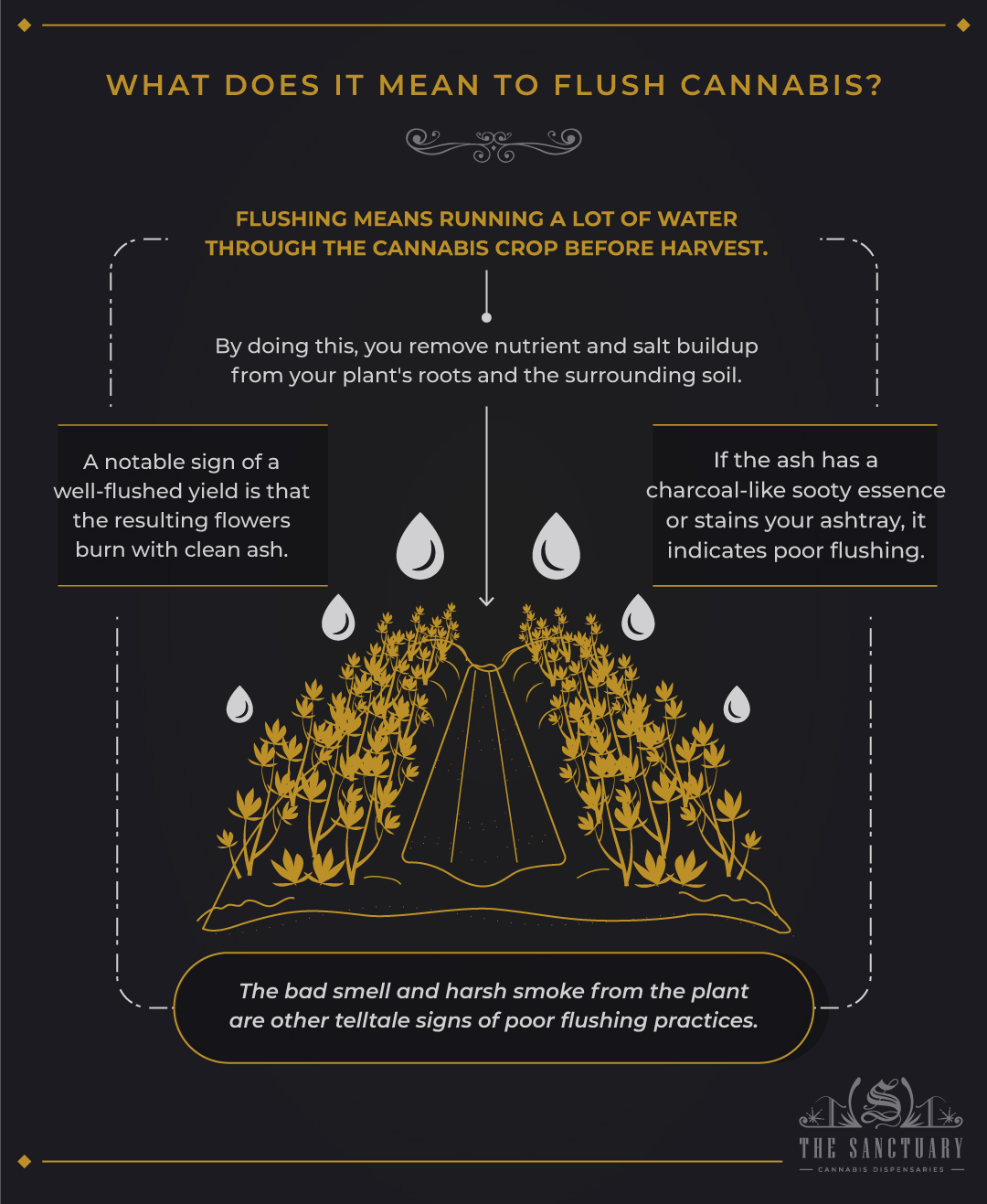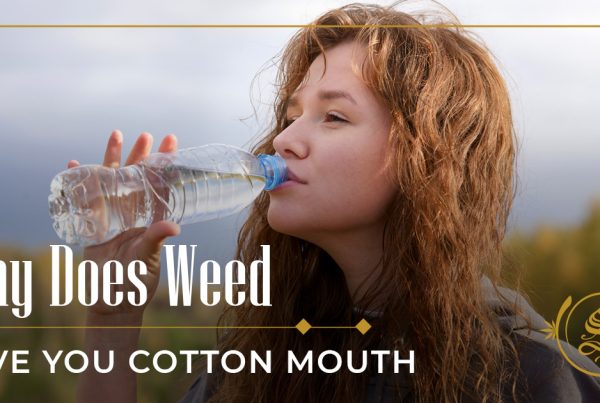A cannabis flush quite simply means adding water to your plants. It helps improve the harvest quality and can make all the difference between dense buds and poor flowers.
But when to flush cannabis? How to flush it? Here’s what you need to know.
What Does It Mean to Flush Cannabis?

Flushing means running a lot of water through the cannabis crop before harvest. By doing this, you remove nutrient and salt buildup from your plant’s roots and the surrounding soil.
In a way, it’s a fresh start for your cannabis plants. Since the flush removes buildup, the plants can use up any nutrients they’ve accumulated over time. The resulting yield is nutrient-rich and healthy.
A notable sign of a well-flushed yield is that the resulting flowers burn with clean ash. However, if the ash has a charcoal-like sooty essence or stains your ashtray, it indicates poor flushing. The bad smell and harsh smoke from the plant are other telltale signs of poor flushing practices.
Sometimes, you may need to flush your cannabis crop for other reasons. For example, if you overfeed or over fertilize your plants, their leaves may shrivel and change color in a process known as nutrient burn. Flushing removes the extra fertilizer or nutrients from the soil, helping the plant recover.
When to Flush Cannabis
Getting the timing right is essential for a proper cannabis flush. If you flush your plants too early, the plant will not get enough nutrients to grow and flower. An excessively early flush will also cause leaf discoloration and yellowing.
The right time to flush is about two weeks before you plan to harvest the plant. For example, a strain with an eight-week flowering period must be flushed in the sixth week.
You can also determine the appropriate flushing time by observing the trichomes. When the trichomes turn a milky color from their former clear appearance, it’s time to flush.
If you want to flush your plants in the vegetative stage to remove extra nutrients, you should first confirm the occurrence of nutrient burn. An abundance of soil nutrients results in a nutrient lockout, reducing the plants’ access to nutrients. You can solve this problem by flushing the crop to rid the soil of unnecessary nutrients.
How to Flush Cannabis Plants?
It’s pretty simple to flush cannabis plants since you only need to overwater them. Here’s the quick step-by-step process.
Step 1: Water the Plants
Tap water works wonders for flushing cannabis plants. Use a hose or a watering can to water your cannabis crop.
Although tap water doesn’t need to be treated, it should have a safe pH level. If the water in your area is too acidic or alkaline, you must treat the water to neutralize its pH before using it to flush cannabis plants.
Step 2: Let Drain
After you’ve flooded the soil with water, let it sit for some time. In a few minutes, the water will absorb extra salt and nutrients from the soil.
Then, water the soil again to remove the nutrient-enriched water. You won’t be able to notice any color difference in water released from outdoor plants. But if you flush potted cannabis plants, the water leaving the drainage holes will be dirty and stained.
Step 3: Check the TDS
The total dissolved solids (TDS) refer to the amount of organic and inorganic matter present in a solution. In this case, TDS is a measure of the nutrients present in the water.
Use a TDS meter to check the water’s nutrient levels. Ideally, you want the TDS of the drained water to be the same as the freshwater.
In the first flush, you’ll notice that the drained water has a high TDS of about 1,300 ppm (parts per million). After multiple flushes, the TDS levels should start to drop. You can stop when the TDS is 50 ppm or close to the freshwater TDS.
Step 4: Check Electrical Conductivity
The nutrients present in the soil conduct electricity, which is why the electrical conductivity of a crop with a nutrient lockout is quite high. Use a conductivity tester to check the water’s electrical conductivity.
You should keep flushing the plant until the electrical conductivity is 0 or about 0.2 mS/cm (millisiemens/centimeter).
Step 5: Check the Color
Besides electricity conductivity and TDS, you can also notice the water’s appearance. The water draining from the plants should be clearer and lighter as more and more nutrients are removed from it.
When Should You Not Flush Cannabis Plants?
Most growers agree that flushing a cannabis crop can help improve its flavor and give a cleaner burn. However, you should avoid flushing the crop if it is being grown in super soil.
Soils with significant amendments have been developed specifically to harbor important microorganisms. Flushing can disrupt the microbial biodiversity of the soil, removing helpful bacteria and fungi from it.
Signs of a Successful Cannabis Flush
You’ll only find out if the cannabis flush was successful once you’ve cured and dried your yield. Here are some signs:
- Good Burn: Flowers from a well-flushed crop burn well. That means you won’t have to relight your joint repeatedly. Instead, it will burn consistently, allowing you to smoke it all the way without reaching for the lighter the second time.
- Clean Ash: The ash will resemble that of a cigarette. It won’t leave any stains on the ashtray. Plus, it will be soft and light gray.
- Good Flavor: Since cannabis flush helps the plant use up all the accumulated nutrients, you can expect the flowers to taste amazing. They will also have a fragrant aroma that will fill up the room once you light up a blunt.
Conclusion
If you believe you did everything from lighting and temperature regulation to strain selection right, but the buds are still disappointing, the lack of flushing might be the culprit.
Flushing your cannabis crop two weeks before harvest will allow the plant to use up all the accumulated nutrients, giving you clean and tasty buds that burn consistently with a clean ash.






